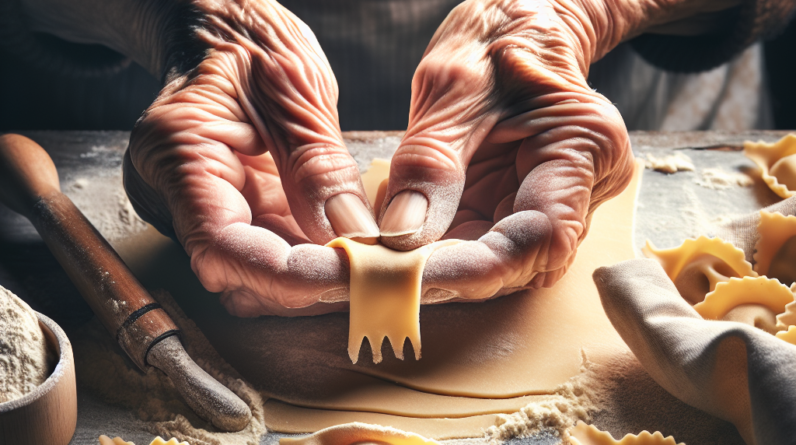Antipasto, a beloved Italian tradition, has been enticing taste buds all over the world for centuries. From its humble origins in ancient Rome to its present-day status as a delightful prelude to a meal, antipasto has a rich history steeped in culture, flavor, and tradition. This delectable assortment of cured meats, cheeses, marinated vegetables, and other savory delights not only tantalizes the senses but also offers a glimpse into the vibrant culinary heritage of Italy. Join us as we uncover the fascinating backstory behind the delicious custom of antipasto and explore its evolution throughout the ages.

The Origins of Antipasto
Ancient Roman Origins
Antipasto, a popular Italian appetizer, has a rich history that dates back to ancient Rome. The word “antipasto” actually means “before the meal” in Italian, and it was traditionally served before the main course as a way to stimulate the appetite. In ancient Rome, an antipasto-like dish called gustatio was commonly enjoyed at lavish feasts. This gustatio featured a variety of small, flavorful dishes such as olives, cured meats, and vegetables.
Greek Influence
The Greek influence on antipasto cannot be overlooked. Ancient Greeks had their own culinary traditions, including meze, which consisted of small plates served as appetizers before the main meal. When the Romans conquered Greece, they adopted many aspects of Greek culture, including their cuisine. So, it is likely that the concept of antipasto was influenced by the Greek tradition of meze.
Middle Ages and Renaissance
During the Middle Ages and Renaissance in Italy, the concept of antipasto remained present but evolved to include more elaborate and complex dishes. As trade routes expanded, Italian merchants had access to a wider variety of ingredients, spices, and flavors, which they incorporated into antipasto. These platters became a symbol of wealth and culinary indulgence during this time.
Spread Across Italy
As Italy grew as a nation, each region developed its own unique variations of antipasto. From Northern Italy to Southern Italy, the flavors, ingredients, and presentation of antipasto evolved to reflect the distinct culinary traditions of each area. This regional diversity has made antipasto a beloved and diverse part of Italian cuisine.
The Evolution of Antipasto Ingredients
Vegetables and Pickled Foods
One of the defining elements of antipasto is the presence of vegetables and pickled foods. Ancient Romans enjoyed a variety of vegetables in their antipasti, such as artichokes, mushrooms, and asparagus. These vegetables were often marinated or pickled to enhance their flavor and preserve them for longer periods of time. Today, pickled vegetables like giardiniera and marinated artichokes are popular components of antipasto.
Cured Meats and Cheeses
Cured meats and cheeses are another essential component of antipasto. Italian cured meats like prosciutto, salami, and coppa are thinly sliced and arranged on antipasto platters to provide a savory and indulgent element. Likewise, a variety of cheeses, such as fresh mozzarella, provolone, and pecorino, are incorporated into antipasto to add richness and depth of flavor.
Fish and Seafood
With Italy’s long coastline, it’s no surprise that fish and seafood are commonly found in antipasto. Anchovies, smoked salmon, marinated octopus, and sardines are just a few examples of the seafood delicacies that can be included. This adds a refreshing and oceanic twist to the antipasto platter, showcasing the abundance of the Mediterranean sea.
Bread and Focaccia
Bread and focaccia are staples of Italian cuisine, and they have also found their way into antipasto. Slices of crusty bread or freshly baked focaccia serve as a vehicle for enjoying the various flavors and textures of antipasto. They can be enjoyed on their own or used to create small open-faced sandwiches with the other ingredients.
Regional Variations of Antipasto
Northern Italy
In Northern Italy, antipasto often features local ingredients such as cured meats, cheeses, and pickled vegetables. Prosciutto di Parma, a famous cured ham from the Emilia-Romagna region, is commonly found in antipasto platters. Cheeses like gorgonzola and fontina add a distinct flavor profile to these northern varieties. In Northern Italy, antipasto is often given a lighter touch, featuring delicate and refined flavors.
Central Italy
In Central Italy, antipasto is characterized by a stronger emphasis on cured meats, such as salami and prosciutto. Traditional dishes like crostini, topped with chicken liver pâté or tomato and mozzarella, are also popular in this region. Antipasti from this area often highlight the simplicity and freshness of local ingredients, utilizing herbs, olive oil, and garlic to enhance flavors.
Southern Italy
Antipasto from Southern Italy showcases the vibrant and bold flavors this region is known for. Ingredients such as marinated eggplant, caponata (a Sicilian eggplant relish), and pepperoncini take center stage. Seafood is also heavily featured in the antipasti from this region, reflecting the area’s close proximity to the Mediterranean Sea. Overall, antipasto from Southern Italy is an explosion of flavors and colors.
Antipasto in Italian Culture
Antipasto as a Social Ritual
In Italian culture, antipasto is more than just a simple appetizer. It is a social ritual that brings people together, encouraging conversation and creating a sense of community. Antipasto is often served at the beginning of a meal, allowing guests to mingle, share stories, and savor the flavors before the main course.
Antipasto in Italian Feasts and Celebrations
Antipasto plays a significant role in Italian feasts and celebrations. Whether it’s a family gathering, a holiday, or a special occasion, antipasto is an essential part of the menu. The variety of ingredients and flavors found in antipasto platters make them a crowd-pleasing and versatile option, ensuring there is something for everyone to enjoy.
Antipasto in Italian Restaurants and Homes
Antipasto is a staple in both Italian restaurants and homes. Many restaurants offer antipasto platters as a standalone dish or as part of a larger tasting menu. In Italian homes, antipasto is often enjoyed during family meals or as a way to welcome guests. It serves as a delicious introduction to the meal and sets the stage for what is to come.

Modern Antipasto Trends
Fusion and Contemporary Flavors
In recent years, antipasto has undergone a modern makeover, embracing fusion and contemporary flavors. Chefs are experimenting with unexpected combinations and incorporating global ingredients to create innovative antipasto dishes. This modern twist brings a fresh and exciting twist to the traditional antipasto experience, appealing to adventurous palates.
Vegan and Vegetarian Options
As the demand for plant-based options continues to rise, antipasto has adapted to cater to vegan and vegetarian diets. Instead of relying solely on animal products, chefs and home cooks are incorporating a variety of vegetables, plant-based proteins, and dairy alternatives to create flavorful antipasto platters that are inclusive and delicious.
Artisanal and Locally-Sourced Ingredients
With a growing focus on sustainability and supporting local businesses, antipasto has seen a rise in the use of artisanal and locally-sourced ingredients. Chefs and home cooks are seeking out high-quality, ethically-produced ingredients to create truly exceptional antipasto experiences. This commitment to craftsmanship and sourcing supports local communities and ensures a higher level of flavor and quality.
Antipasto Beyond Italy
Influence on Mediterranean Cuisine
Antipasto has had a significant influence on the broader Mediterranean cuisine. Countries like Greece, Spain, and France have adopted their own versions of antipasto, incorporating local flavors and ingredients. While each country puts its own unique twist on the concept, the idea of a pre-meal appetizer platter is a common thread that connects them all.
Adaptations in Other Countries
Antipasto has also made its way into the culinary traditions of other countries outside of the Mediterranean region. In the United States, Italian immigrants introduced antipasto to the American palate, and it has become a beloved part of Italian-American cuisine. Other countries, such as Argentina and Brazil, have also embraced antipasto, incorporating local ingredients and flavors to create their own interpretations of this culinary tradition.

Antipasto Recipe Ideas
Classic Antipasto Platter
Creating a classic antipasto platter is a wonderful way to appreciate the diverse flavors and textures of Italian cuisine. Start with a selection of cured meats such as prosciutto, salami, and mortadella. Add a variety of cheeses, such as mozzarella, provolone, and gorgonzola. Include pickled vegetables like marinated artichokes, olives, and roasted red peppers. Finally, don’t forget to add slices of crusty bread or focaccia to complete the experience.
Antipasto Skewers
For a fun and visually appealing twist on antipasto, try making antipasto skewers. Thread a combination of marinated vegetables, such as cherry tomatoes, marinated mushrooms, and artichoke hearts, onto skewers. Add cubes of cheese, like fresh mozzarella or provolone, and finish off with slices of cured meats. Drizzle with olive oil and sprinkle with fresh herbs for a burst of flavors.
Antipasto Pasta Salad
Turn antipasto into a satisfying and refreshing pasta salad. Cook your favorite pasta, such as penne or fusilli, and let it cool. In a large bowl, combine the pasta with diced cured meats, like salami and prosciutto, as well as a variety of vegetables, such as cherry tomatoes, cucumber, and black olives. Toss everything together with a tangy vinaigrette made from olive oil, balsamic vinegar, and Italian herbs. Serve chilled and enjoy!
The Popularity of Antipasto
Antipasto in Italian-American Culture
Antipasto has gained immense popularity in Italian-American culture. The tradition of serving antipasto at family gatherings, holidays, and special occasions has been passed down through generations. Italian-American delis and restaurants often feature antipasto platters as a mainstay on their menus, catering to the nostalgic flavors and customs of the Italian-American community.
International Recognition
Antipasto has gained international recognition as a beloved Italian appetizer. Its versatility, vibrant flavors, and beautiful presentation have made it a popular choice for both casual meals and formal events. People from all around the world have embraced antipasto as a delicious way to explore the rich and diverse flavors of Italian cuisine.
Tips for Enjoying Antipasto
Pairing Antipasto with Wine
When enjoying antipasto, it’s important to consider wine pairings that complement the variety of flavors and textures. For cured meats and cheeses, a light and fruity red wine like Chianti or a dry white wine like Pinot Grigio can be ideal. If seafood is a prominent part of the antipasto, a crisp and acidic white wine such as Sauvignon Blanc can bring out the flavors. Ultimately, it’s about finding a wine that complements your personal preferences and the specific ingredients on your antipasto platter.
Serving and Presentation Tips
To make the most of your antipasto experience, consider these serving and presentation tips. Arrange the ingredients on a large platter or wooden board, creating a visually appealing display. Vary the colors, textures, and heights of the components to create an eye-catching presentation. Offer small forks, toothpicks, or slices of bread to make it easy for guests to enjoy each element. Finally, encourage guests to explore and experiment with different combinations of flavors to fully appreciate the complexity of the antipasto.
Conclusion
The origins of antipasto can be traced back to ancient Rome and Greece, with its evolution in Italian culture creating a rich and diverse tradition. From the variety of ingredients to the regional variations, antipasto has become a beloved part of Italian cuisine. Its influence has spread beyond Italy, leaving a mark on Mediterranean and international culinary traditions. With its modern adaptations and popularity in Italian-American culture, antipasto continues to captivate our taste buds and bring people together. So, the next time you have the opportunity to indulge in antipasto, savor the flavors, embrace the moment, and appreciate the rich history of this delicious culinary tradition.










